The Fundamental Unit of Life Class 9 Notes Science Chapter 5
| Table of contents |

|
| Introduction |

|
| What are Living Organisms Made Up of? |

|
| Discovery of Cell & Cell Theory |

|
| What is a Cell Made Up Of? |

|
| Cell Division |

|
Introduction
- In 1665, Robert Hooke examined cork with a microscope he designed himself and noticed its honeycomb-like structure made of tiny compartments.
- Cork comes from tree bark, and Hooke called these compartments "cells," a term that comes from the Latin word for "a little room."
- This was the first time anyone had seen that living things seem to consist of separate units.
- The term "cell" is still used today in biology to describe these units.
- Robert Hooke's discovery of cells in cork marked a major milestone in scientific history.
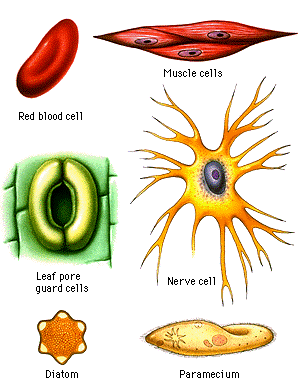 Cells can have different Shaped and Sizes
Cells can have different Shaped and Sizes
What are Living Organisms Made Up of?
- Cells were first discovered by Robert Hooke in 1665 when he used a simple microscope to look at cork.
- Living organisms are made of similar structures that combine to create larger structures.
- Cells are the fundamental building blocks of living things, visible as tiny structures under a microscope.
- All organisms, including onions, consist of cells that can exist alone or in groups.
- Unicellular organisms, like Amoeba and bacteria, are made up of a single cell, which forms the entire organism.
- Multicellular organisms, such as some fungi, plants, and animals, are made of many cells that perform different tasks in various body parts.
- Cells reproduce by dividing to create more cells of the same kind.
- The shape and size of cells relate to the specific function they serve.
- Each living cell can perform certain basic functions typical of all living beings.
- In multicellular organisms, like humans, there is a division of labour among different body parts.
- Cells contain special parts known as cell organelles that carry out essential functions for the cell's survival.
- All cells possess the same organelles, regardless of their function or the organism they belong to, although their roles may differ based on cell type and organism.
- The cell theory, stating that all plants and animals are made of cells and that cells are the basic unit of life, was introduced by Schleiden (1838) and Schwann (1839).
- The central vacuole in some plant cells can take up 50-90% of the cell’s volume.
Discovery of Cell & Cell Theory
- Cells were first seen by Robert Hooke in 1665 when he looked at a cork slice with a simple microscope. He observed that the cork appeared like a honeycomb with many small compartments. The word "cell" is from the Latin term meaning "a little room."
- In 1674, Leeuwenhoek, using a better microscope, found free-living cells in pond water.
- Robert Brown identified the nucleus inside cells in 1831.
- In 1839, Purkinje introduced the term 'protoplasm' for the fluid inside the cell.
- The cell theory, proposed by Schleiden in 1838 and Schwann in 1839, states that all plants and animals consist of cells, making the cell the basic unit of life. This term is still widely used in biology today.
- Virchow expanded the cell theory in 1855 by stating that all cells originate from pre-existing cells.
- The invention of the electron microscope in 1940 enabled scientists to examine the complex structure of cells and their organelles.
What is a Cell Made Up Of?
Cells are the basic building blocks of life. They have similar structures called organelles, regardless of their specific functions or the type of organism they belong to. Organelles, such as the nucleus and cytoplasm, support various activities and interactions within the cell.
The Structure of Cells in Plants and Animals
Along with the plasma membrane, plant cells have a sturdy outer layer known as the cell wall. This wall is located outside the plasma membrane and is mostly made up of cellulose. The cell wall allows plant, fungal, and bacterial cells to survive in dilute environments without bursting.
The nucleus in eukaryotic cells is encased in a double-layered membrane and controls the cell's life functions. Key organelles include:
- Endoplasmic reticulum
- Golgi apparatus
- Lysosomes
- Mitochondria
- Plastids
The flexible nature of the cell membrane allows it to take in food and other substances from outside through a process called endocytosis.
Plasma Membrane or Cell Membrane
- The plasma membrane is the outer layer of a cell, managing what enters and exits. It separates the cell's contents from the outside environment.
- Gases like CO2 and O2 enter and leave cells through a process called diffusion.
- Osmosis refers to the movement of water through a selectively permeable membrane, which depends on the concentration of solutes.
- In a hypotonic solution, cells take in water; in an isotonic solution, there is no net movement of water; while in a hypertonic solution, cells lose water.
- The plasma membrane restricts the movement of certain materials, emphasising its role in selective permeability.

- Diffusion and osmosis are essential for the exchange of gases and water in cells.
- Various molecules enter and exit the cell via a transport method that requires energy.
- The plasma membrane consists of organic molecules known as lipids and proteins. It can only be seen using an electron microscope. The membrane's flexibility allows the cell to take in food and other materials from the outside, a process known as endocytosis.
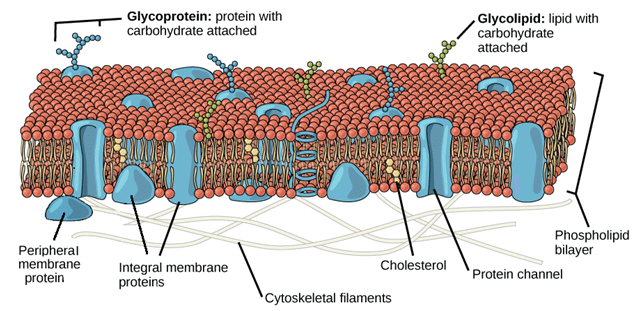 The Plasma Membrane
The Plasma Membrane
Cell Wall
- Plant cells have a strong outer layer known as the cell wall, which is located outside the plasma membrane. This wall is primarily made of cellulose, a complex material that gives plants their structural strength.
- Plasmolysis refers to the process where the contents of a living plant cell shrink away from the cell wall due to loss of water.
- Cell walls allow the cells of plants, fungi, and bacteria to endure very dilute (hypotonic) environments without bursting.
Nucleus
- The nucleus in eukaryotic cells is enclosed by a double-layered membrane and it controls the cell's life processes.
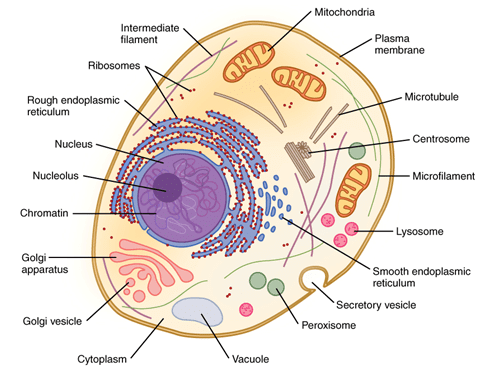 Nucleus of a Cell
Nucleus of a Cell
- Chromosomes consist of DNA and proteins, with genes acting as functional segments of DNA.
- The nucleus is essential for cellular reproduction and regulates the cell's chemical activities.
- Prokaryotic cells lack membrane-bound organelles; their chromosomes are made up of only nucleic acid and they contain very small ribosomes.
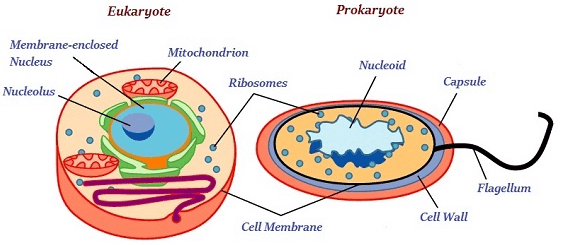 Eukaryotic and Prokaryotic Cells
Eukaryotic and Prokaryotic Cells
Eukaryotic and Prokaryotic Cells
- Most mature plant cells have a large central vacuole that helps maintain the cell's turgidity and stores vital substances.
Cytoplasm
- The cytoplasm is the fluid found inside the plasma membrane, containing specialised cell organelles. Some organelles can only be seen with an electron microscope.
- In eukaryotic cells, organelles are membrane-bound and have specific functions.
- The role of membranes can be understood through viruses, which lack membranes and do not exhibit life until they enter a living host and use its cellular machinery to reproduce.
Cell Organelles
- Cells utilise membrane-bound organelles to segregate different chemical processes.
- Organelles such as the endoplasmic reticulum, Golgi apparatus, lysosomes, mitochondria, and plastids are essential for various cell functions.
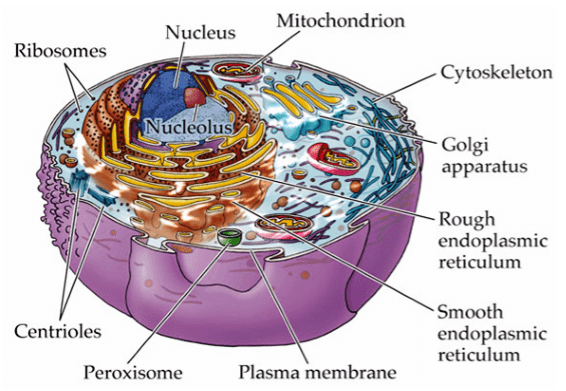 Different Cell Organelles
Different Cell Organelles
Endoplasmic Reticulum (ER)
- A vast network of membrane-bound tubes and sheets.
- Includes rough ER (RER) with ribosomes for protein synthesis and smooth ER (SER) for lipid production. The ER also acts as a cytoplasmic framework, providing a surface for some biochemical activities.
- One of the ER's functions is to serve as channels for transporting materials, especially proteins, between different parts of the cytoplasm or between the cytoplasm and the nucleus.
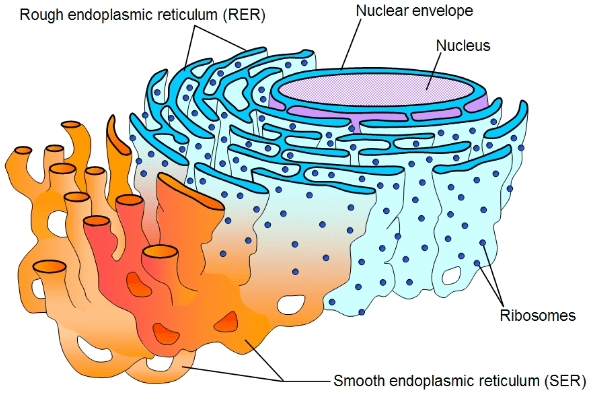 Endoplasmic Reticulum
Endoplasmic Reticulum
Golgi Apparatus
- A system of membrane-bound vesicles that is involved in packaging and modifying cellular products.
- It plays a role in sugar synthesis and the creation of lysosomes.
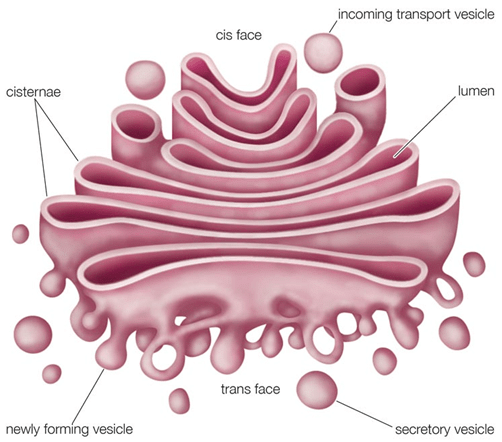 Golgi Apparatus
Golgi Apparatus
Lysosomes
- Lysosomes are often referred to as the "suicide bags" of the cell, containing membrane-bound sacs filled with digestive enzymes for breaking down waste.
- They are responsible for degrading foreign materials and old organelles.
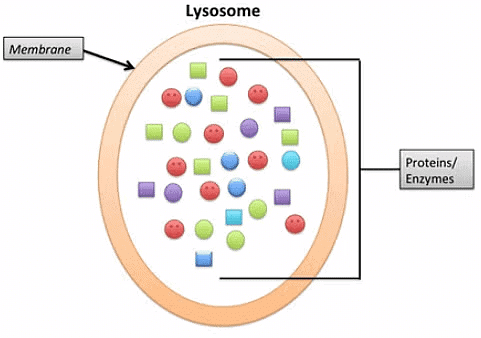
Mitochondria
- Known as the powerhouses of the cell, they produce ATP, which provides energy.
- Mitochondria contain their own DNA and ribosomes, which assist in protein synthesis.
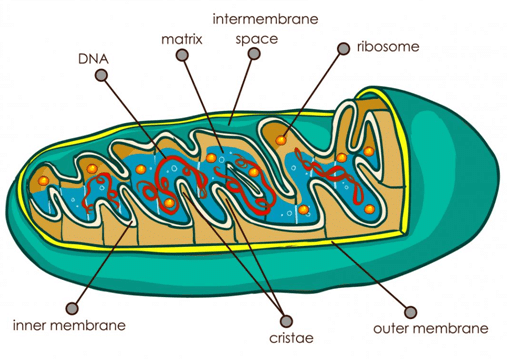 Mitochondria
Mitochondria
Plastids
- Found in plant cells, plastids include chloroplasts for photosynthesis and leucoplasts for storage.
- Similar to mitochondria, they have their own DNA and ribosomes.
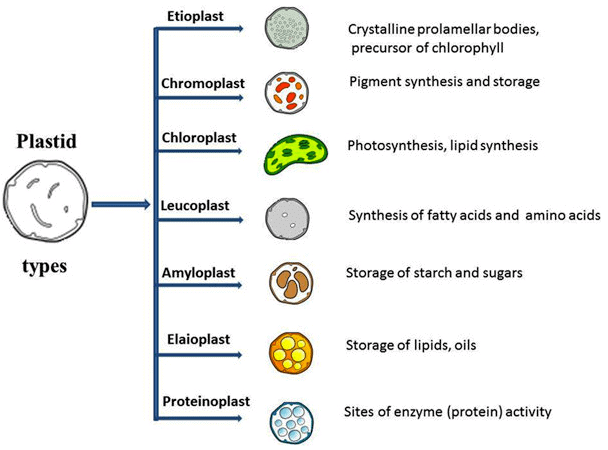 Types of Plastids
Types of Plastids
Vacuoles
- In plant cells, vacuoles are filled with cell sap, which helps to keep the cell firm and strong.
- Vacuoles store many important substances for the plant cell, including amino acids, sugars, various organic acids, and some proteins.
- Plant cells have large vacuoles, while those in animal cells are smaller.
- In some plant cells, the central vacuole can take up 50-90% of the cell's volume.
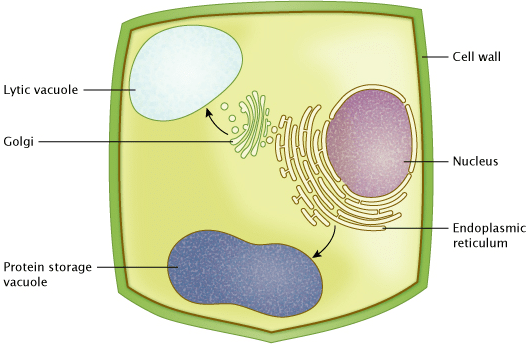 Vacuoles in plant cells
Vacuoles in plant cells
Cell Division
- The process of creating new cells is known as cell division. There are two primary types: mitosis and meiosis.
- Mitosis is the method of cell division mainly used for growth. In mitosis, a single cell, called the mother cell, splits to produce two identical daughter cells. These daughter cells contain the same number of chromosomes as the original mother cell. This process is vital for growth and tissue repair in living organisms.
- In contrast, specific cells in the reproductive organs of animals and plants create gametes through a different process called meiosis. This involves two successive divisions, resulting in four new cells instead of two. Importantly, these new cells possess half the number of chromosomes compared to the mother cells.
|
84 videos|478 docs|60 tests
|
FAQs on The Fundamental Unit of Life Class 9 Notes Science Chapter 5
| 1. What are living organisms made up of? |  |
| 2. What is cell theory? |  |
| 3. What are cells made up of? |  |
| 4. What is cell division? |  |
| 5. What is the significance of cells being the fundamental unit of life? |  |





















